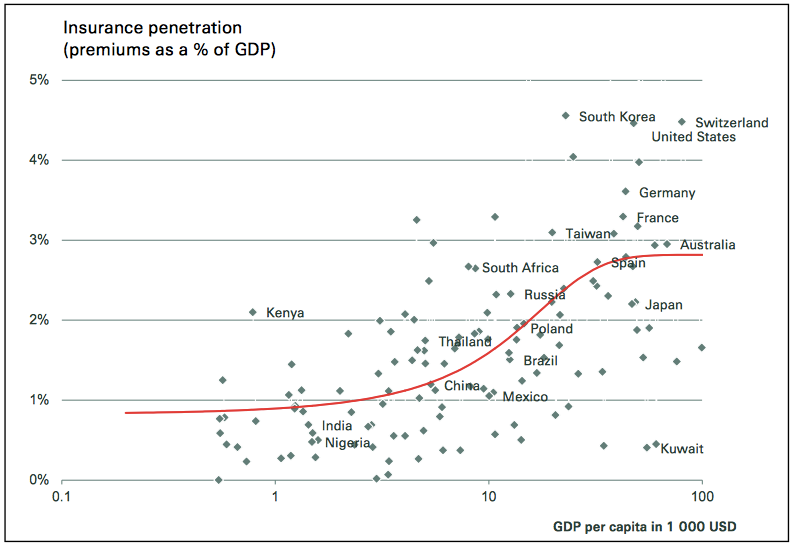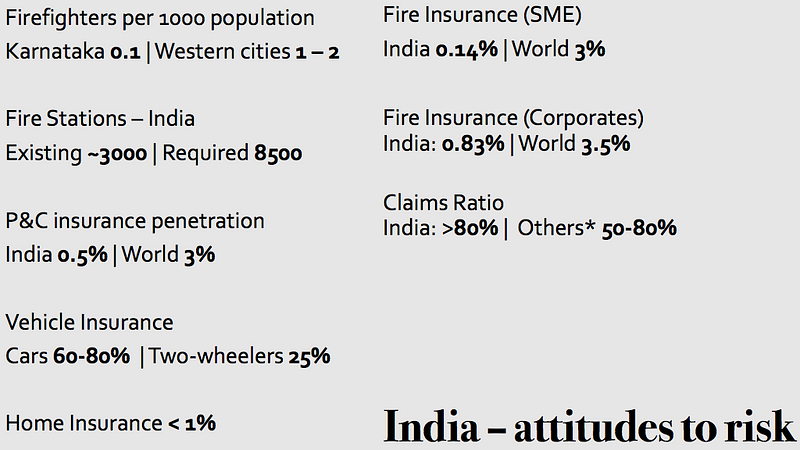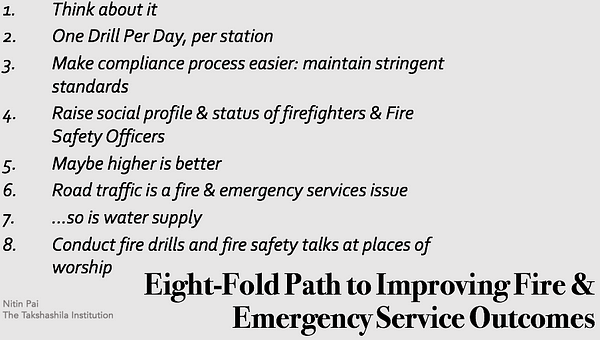Nitin Pai
Can we enlist religious institutions in the cause to promote fire safety?
As part of my Beyond Carlton Memorial Lecture at the headquarters of the Karnataka Fire and Emergency Services last night, I engaged in some loud thinking on why Indians (maybe others too, but I’m primarily concerned about Indians) have a cavalier attitude towards safety.
In the following chart, we see that not only do Indians under-invest in insurance, we are below the trend line when compared to other countries in the same income group.
 Non-life insurance penetration (premiums as share of GDP) vs GDP per capita (2013) — Source: Swiss Re
Non-life insurance penetration (premiums as share of GDP) vs GDP per capita (2013) — Source: Swiss Re
As the second chart (below) shows, insurance penetration among motorists, home owners, SMEs and corporates is below world averages.
 Compiled by Nitin Pai/The Takshashila Institution; using data from FICCI, McKinsey & Co & other sources
Compiled by Nitin Pai/The Takshashila Institution; using data from FICCI, McKinsey & Co & other sources
Why might this be the case?
Risks are underestimated and people are confident that it won’t happen to me. No figure illustrates this better than the fact that only 25% of two-wheelers have insurance when they are the most likely to suffer injuries and loss of life in road accidents.
Risks are asymmetric, different people value the potential damage differently, limiting cooperation in investing in safety measures. It is possible that the stakes are too small for a lot of people to bother about the risks.
Fatalism is pervasive: faith in destiny, the almighty and the afterlife discount the importance of human actions to prevent and mitigate accidents (like using safety equipment or purchasing insurance.)
Government support (like ex-gratia payments) and social support make insurance premiums a relatively costlier option. Social support is a good thing, but relying on it to the exclusion of self-help is not.
Bad habits like unscrupulous behaviour, poor work culture and poor quality consciouness are pervasive.
Weak liability regime and slow, unreliable judicial processes encourage irresponsible behaviour and discourage those who seek to punish it.
Regulatory complexity makes it hard for people to comply with safety regulations even if they desire to.
We are obviously looking at a Mahatma Grade Problem: too big and too complex for mere public policy to solve. Yet, there might be some ideas from behavioural economics and psychology that could inform public policy solutions.

Among the eight ideas I discussed last evening was this one: what if religious leaders and places of worship are enlisted in building awareness on fire safety and risk management?
If religious leaders encourage people to install fire safety equipment, organise fire drills and promote insurance, we could perhaps use existing social beliefs to change habits.
Given political sensitivities & constraints, fire departments might be reluctant to partner religious institutions: but citizens’ groups interested in promoting fire safety do not face similar constraints.
It’s worth a try.
No comments:
Post a Comment